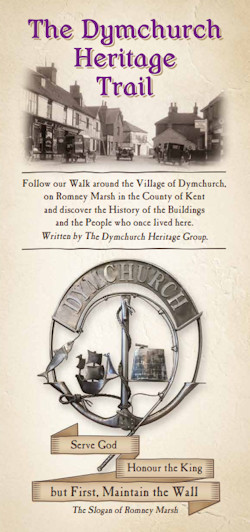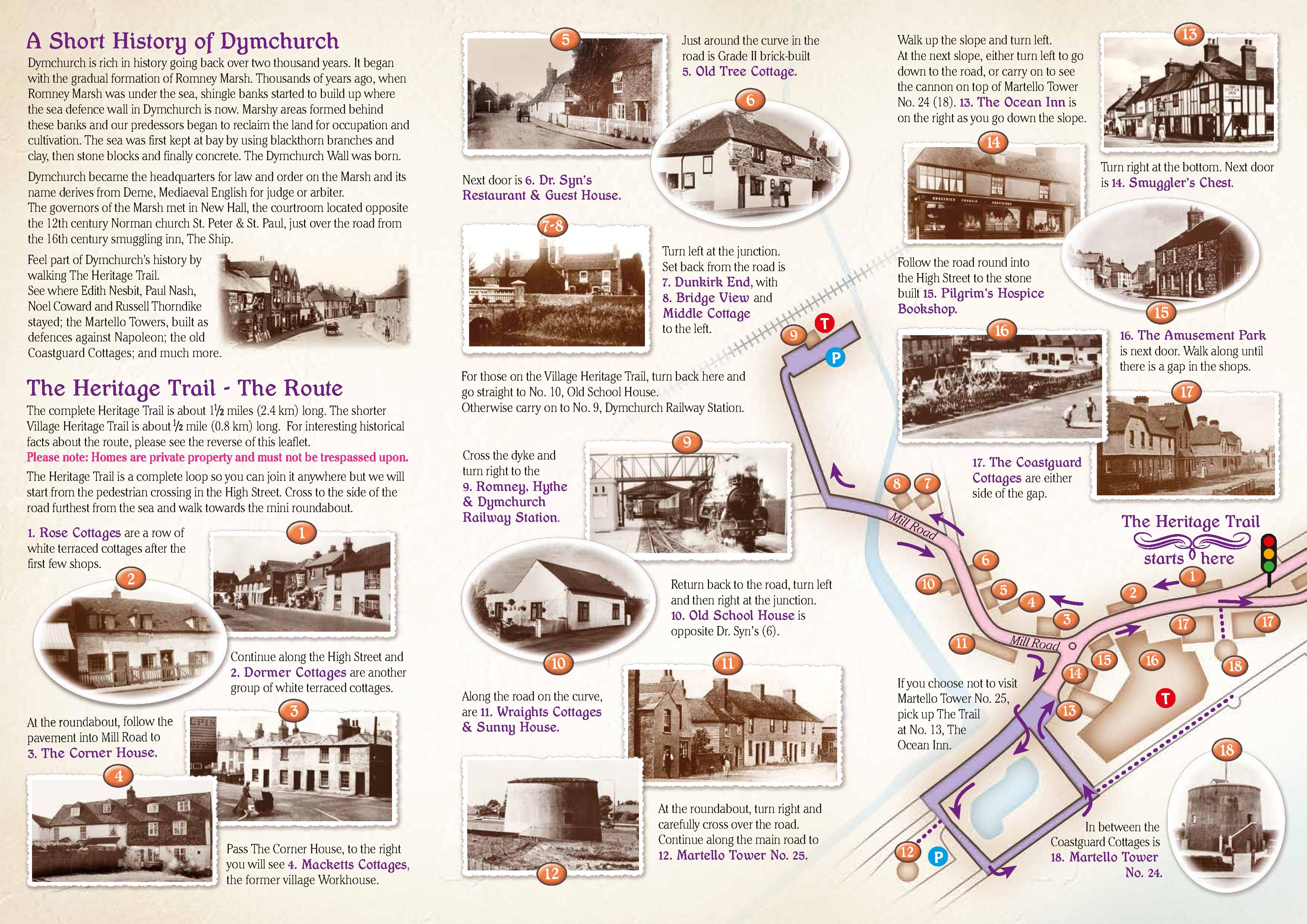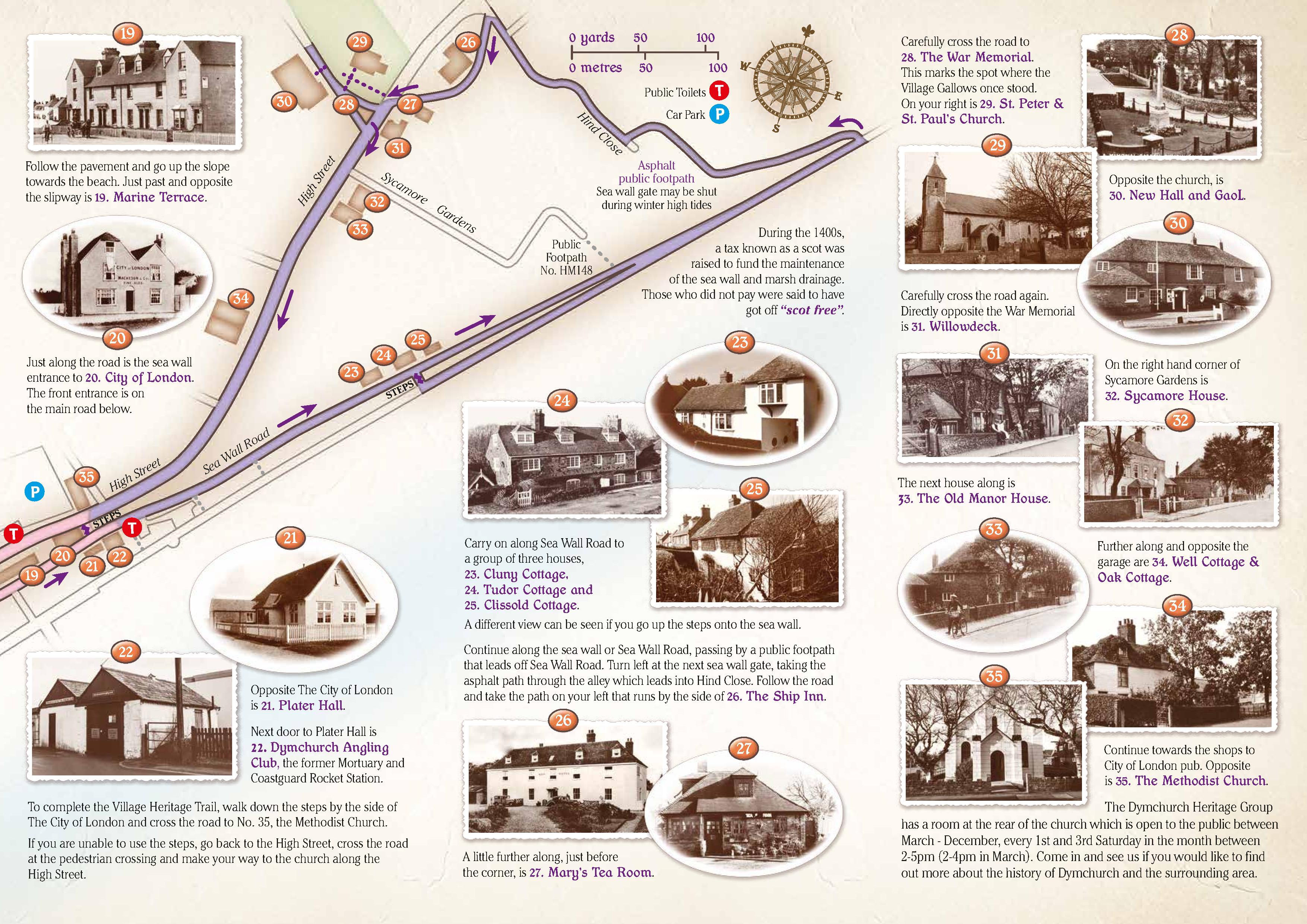Dymchurch Heritage Trail

Other links
![]() Dymchurch Heritage Trail Map (overview of the whole route)
Dymchurch Heritage Trail Map (overview of the whole route)
![]() A Short History of Dymchurch
A Short History of Dymchurch
![]() Dymchurch & District Heritage Group
Dymchurch & District Heritage Group
Part 1 of the Map - covers buildings 1 to 18 on the Trail Route

Part 2 of the Map - covers buildings 19 to 35 on the Trail Route


Buildings on the Dymchurch Heritage Trail
1. Rose Cottages, 49-55 High Street
During the 18th century until 1842 the Rose Inn was situated in one of these cottages and, in 1793, William Wood was the landlord. The artist Paul Nash lived here in 1923.
2. The Dormer Cottages, 19-27 High Street
Built in the 15th century, one of them became Smiths Stores, this is now the Hospice Furniture shop. The cottages have at different times had some famous people living here, including Edith Nesbit, Noel Coward and the artist Paul Nash.
3. The Corner House Restaurant
Alex’s Pie and Eel shop was situated here in the 1950’s to 1970’s. It was formerly four residences known as Allcorn Cottages
4. Mackett’s Cottages, 10-16 Mill Road
Built in 1740, they became the village workhouse in 1791. In 1836, it was closed and the inmates were transferred to the Union Workhouse in New Romney.
5. Old Tree Cottage, 22 Mill Road
A Grade II listed 18th century originally for agriculture workers. Between the 1920’s and 1950’s, it was owned by the notable actor/director Milton Rosmer. Some of his productions were Lady Windermere’s Fan (1916), Little Women (1917), Wuthering Heights (1920) and Goodbye Mr. Chips (1939). He befriended Russell Thorndike and produced his film Dr. Syn in 1937.
6. Dr.Syn’s Restaurant and Guest House, 24 Mill Road
This building has seen many changes, a Grade II listing, originally it was a residential cottage called Mewslade which later became known as The Cat & Kettle tearooms. After then it became Dr.Syn’s Restaurant and later Guest House.
7. Dunkirk End, 26 Mill Road
There is a date stone on Dunkirk End of 1736 together with the masons' marks A.K. & R.H. To the left is a herring hang where the fisherman used to smoke their fish. This building is Grade II listed and the small window in the gable end that looks down Mill Road is believed to have been a smuggler’s lookout
8. Bridge View & Middle Cottage, 24 Mill Road
These two cottages to the left of Dunkirk End date from the late 1700s and many local families have lived here.
9. The Romney, Hythe & Dymchurch Railway
This 15” gauge railway was the passion of Captain J.E.P. Howey and was opened on the 16th July 1927. During World War II it was requisitioned by the War Department which ran a miniature armoured train. The railway also helped with the building of the PLUTO pipe line that stretch the ocean to France. Dymchurch Windmill was on this site until it was demolished in 1906.
10. Old School House, 15 Mill Road
Built in 1800 by Jeremiah Wraight as a village school, the Parish paid him 4 guineas per annum rent. Mr. George Roberts was the first school master in November 1800.
11. Wraights Cottages, 7-13 Mill Road
Built in the 1700s, during 1819 William Wincles lived here and was, like many of the villagers, a smuggler. On the 26th March 1819 he was seized by a Custom Officer on Dymchurch beach. He was tried in New Hall Court, found guilty and sentenced to 3 months in gaol. If you can, pay a visit to New Hall and the Gaol where you will see where William Wincles has carved his name and date on the wall.
12. Martello Tower No. 25 (in the car park)
In 1841 there were 23 people living here in very cramped conditions. During the night of 12th June 1944 two Royal Observer Corps, Mr Archie Wraight and Mr Ernest Woodland, reported the sighting of the first V1 'Doodlebug' to cross our shores. 2,400 of these bombs fell on Kent.
13. The Ocean Inn, 2 High Street
Built in 1733 and the mason’s mark has the initials I.F.E. The earliest records show that in 1840 William Parris was the owner and landlord of The Ocean beerhouse. The name was changed to The Victoria in 1897, possibly to commemorate Queen Victoria’s diamond jubilee. In 1952 during renovations the original name was found on a mural behind the wallpaper and it was decided to change the name back to The Ocean. The mural is on the wall for all to see.
14. Smugglers Chest, 4 High Street
Dating from 1784, the same William Parris was the first known owner.In 1794, because of the lack of small coinage in circulation, he issued his own halfpenny token. Wellworth Stores was here for 32 years until 2003.
15. Hospice Book Shop, 10 High Street
Formerly five cottages, the Hoper family lived in the front two cottages in the High Street around 1891, where they sold sweets and bakery produce. In 1939 Beatrice Hoper, with the help of her mother, took over the shop and called it Beats Sweet Shop. After Beatrice died, her sister took it over and when she retired it was sold to Iris Findley. Iris died in 1999 she left the shop to The Pilgrims Hospice.
16. Dymchurch Amusement Park (MW's Fairground)
In the 1930’s this was a small fairground with a putting green. Prior to this, it had been allotments for the Coastguards. The roller skating rink, is still there under the ghost train.
17. Coastguard Cottages, Coastguard Cottages, 26-40 High Street
Built in 1905, they replaced the cottages that were in the garage car park opposite Well Cottage and Oak Cottage (No.34). They are either side of Martello 24 in the middle of the village.
18. Martello Tower 24
Built in 1806, this Martello Tower is now owned by English Heritage and is open to the public on particular days. If it is open, do take the opportunity to pay a visit to this wonderfully restored building of the Napoleonic period.
19. Marine Terrace, 50-60 Sea Wall
This large block of buildings includes The Arcade Gift Shop and was built by Frank Elliott in 1895 for the Stoakes-Jones family. These were the first houses built as holiday residences in Dymchurch. Russell Thorndike, the author of the Dr.Syn books lived in Nos. 3 and 4 with his parents and siblings.
20. City of London Public House
Built in the 1700’s, it is mentioned in Russell Thorndike’s Dr.Syn books where he called it The Seawall Tavern. Jonah Lorden was the landlord in 1841.
21. The Plater Hall
This memorial hall was built in 1908 in memory of the popular vicar of Dymchurch, the Rev. Charles Eaton Plater. When he died the people of the village paid to have the hall built.
22. Dymchurch Angling Club
This little building was, in it’s early days, the Coastguards Rocket Apparatus Station No. 131. It became the Dymchurch Mortuary between 1939-1963. During World War II many servicemen's bodies were placed in here, including German airmen. Now it is the HQ of Dymchurch Angling Club.
23. Cluny Cottage, 3 Sea Wall Road
Built in 1710, it was little changed until Brigadier General Gordon Macpherson CBE and his wife added the tower room and arch in the 1930s. Prior to that, it was owned by the Stoakes-Jones family who were very prominent in the village.
24. Tudor Cottage, 4 Sea Wall Road
Before 1791, this was one of the original Poor Houses in the village. It had it’s own school room and chapel and is a listed building.
25. Clissold Cottage, 6 Sea Wall Road
This Grade II listed building was built in the early 19th century. In 1843, a fisherman called William Tolhurst lived here. He was heavily involved in smuggling.
26. The Ship Inn
Dating back to the 16th century,it was a coaching inn and haven for smugglers. There are many secret hiding places and a secret tunnel that led across the road to the church. The main road used to beat the front of the pub and it went on the run alongside the sea wall.
27. Mary’s Tearoom, 110 High Street
This was one of two blacksmiths forges in Dymchurch and, in 1670, Andrew Clifford worked here. He issued his own coinage due to the lack of small change.
28. The War Memorial
This land was given by the Lords of the Level of Romney Marsh and was the original site of the Dymchurch gallows. The War Memorial was paid for by the people of the village in memory of those men who gave their lives during World War I.
29. St. Peter & St. Paul Parish Church
A Norman church built circa 1150. Inside, there is a Norman arch that divides the nave and chancel. The church was enlarged in 1821 because of the growing population.
30. New Hall and Gaol
In 1252, a Charter by King Henry III granted self government to Dymchurch and the Romney Marsh, provided they maintained the seawall. Dymchurch was the seat of government but, unfortunately, the original building burnt down in 1573. In 1574, New Hall was built to replace it. Inside there is an 18th century courtroom, a museum and a wealth of history. William Pitt, Prime Minister, came here to discuss building The Martello Towers and Military Canal. The Gaol is to the right of the front door. Inside there are drawings and words carved by the prisoners who were held here.
31. Willowdeck, 108 Hight Street
Once known as Laburnham Cottage, it was the home of Sir Edward Elgar’s great grandparents. William Elgar married Catherine Moate in the parish church on the 29th June 1786.
32. Sycamore House, 102 High Street
This was Sycamore Farmhouse and Sycamore Gardens was the farm. This Grade II listed building has also been the village rectory. Edith Nesbit rented this property and she used to call it “The Other House”. Her friends used to stay here when visiting and holiday.
33. The Old Manor House, 100 High Street
A 17th century listed building that was owned by Sir Edward Dering of Pluckley. His ancestor, also Sir Edward Dering, was the MP for New Romney 1761-70, 1774-87. The family had a long connection to Dymchurch.
34. Well and Oak Cottage, 119-121 High Street
Built in the 17th century, Oak Cottage was the village post office for may years. Well Cottage was another of the properties where Edith Nesbit resided. To the rear of this property was one of the village water pumps used before mains water came to Dymchurch in 1926.
35. Methodist Church, High Street
Erected in 1880 and was built to replace a small chapel that was where The Deck Amusements are now.



















